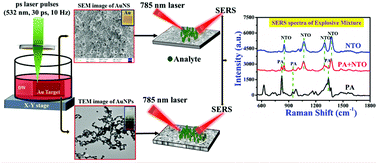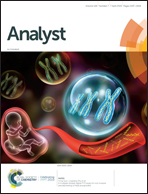SERS based detection of multiple analytes from dye/explosive mixtures using picosecond laser fabricated gold nanoparticles and nanostructures†
Abstract
Surface enhanced Raman spectroscopy (SERS) is a cutting edge analytical tool for trace analyte detection due to its highly sensitive, non-destructive and fingerprinting capability. Herein, we report the detection of multiple analytes from various mixtures using gold nanoparticles (NPs) and nanostructures (NSs) as SERS platforms. NPs and NSs were achieved through the simple approach of laser ablation in liquids (LAL) and their morphological studies were conducted with a UV-Visible absorption spectrometer, a high resolution transmission electron microscope (HRTEM) and a field emission scanning electron microscope (FESEM). The fabricated NPs/NSs allowed the sensitive and selective detection of different mixed compounds containing (i) rhodamine 6G (Rh6G) and methylene blue (MB), (ii) crystal violet (CV) and malachite green (MG), (iii) picric acid (explosive) and MB (dye), (iv) picric acid and 3-nitro-1,2,4- triazol-5-one (explosive, NTO) and (v) picric acid and 2,4-dinitrotoluene (explosive, DNT) using a portable Raman spectrometer. Thus, the obtained results demonstrate the capability of fabricated SERS substrates in identifying explosives and dyes from various mixtures. This could pave a new way for simultaneous detection of multiple analytes in real field applications.



 Please wait while we load your content...
Please wait while we load your content...